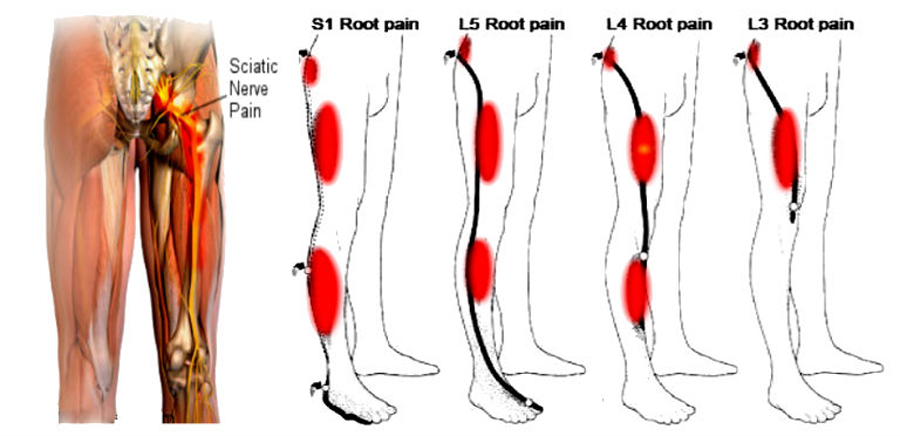Prognostic Implications of the Quebec Task Force Classification of Back-related Leg Pain:
An Analysis of Longitudinal Routine Clinical Data
SOURCE: BMC Musculoskelet Disord. 2013 (May 24); 14: 171
Alice Kongsted, Peter Kent, Tue Secher Jensen, Hanne Albert and Claus Manniche
Research Department,
The Spine Centre of Southern Denmark,
Middelfart, Hospital Lillebaelt,
Institute of Regional Health Services Research,
University of Southern Denmark,
Middelfart, Denmark
BACKGROUND: Low back pain (LBP) patients with related leg pain have a more severe profile than those with local LBP and a worse prognosis. Pain location above or below the knee and the presence of neurological signs differentiate patients with different profiles, but knowledge about the prognostic value of these subgroups is sparse. The objectives of this study were (1) to investigate whether subgroups consisting of patients with Local LBP only, LBP + leg pain above the knee, LBP + leg pain below the knee, and LBP + leg pain and neurological signs had different prognoses, and (2) to determine if this was explained by measured baseline factors.
METHODS: Routine clinical data were collected during the first visit to an outpatient department and follow-ups were performed after 3 and 12 months. Patients were divided into the four subgroups and associations between subgroups and the outcomes of activity limitation, global perceived effect (GPE) after 3 months, and sick leave after 3 months were tested by means of generalised estimating equations. Models were univariate (I), adjusted for duration (II), and adjusted for all baseline differences (III).
RESULTS: A total of 1,752 patients were included, with a 76% 3-month and 70% 12-month follow-up. Subgroups were associated with activity limitation in all models (p < 0.001). Local LBP had the least and LBP + neurological signs the most severe limitations at all time-points, although patients with neurological signs improved the most. Associations with GPE after 3 months were only significant in Model I. Subgroups were associated with sick leave after 3 months in model I and II, with sick leave being most frequent in the subgroup with neurological signs. No significant differences were found in any pairwise comparisons of patients with leg pain above or below the knee.
There are more articles like this @ our:
Chiropractic and Sciatica Page and the:
CONCLUSIONS: Subgrouping LBP patients, based on pain location and neurological signs, was associated with activity limitation and sick leave, but not with global perceived effect (GPE). The presence of neurological signs and pain in the leg both have prognostic implications but whether that leg pain without neurological signs is above or below the knee does not.
Keywords: Classification, Longitudinal studies, Low back pain, Prognosis, Sciatica
From the FULL TEXT Article
Background
It is widely believed that the identification of homogeneous subgroups of low back pain (LBP) patients is important for the optimal prediction of prognosis and care. [1, 2] LBP patients with leg pain are reported to differ from those with local LBP only, both in terms of general clinical characteristics and prognosis. However, patients with leg pain do not form a single homogenous group and the association between leg pain and prognosis is quite weak. [3–5] More detailed examination of subgroups within the leg pain population [6, 7] may lead to identification of stronger prognostic indicators.
LBP-related leg pain has been subgrouped into pain above the knee, pain below the knee and leg pain with neurological signs. [6] Classifying patients into these three subgroups and patients with local LBP only, as described by the Quebec Task Force on spinal pain (QTF), has shown associated differences on a number of clinical characteristics that display a generally increasing severity from patients with local LBP, across the categories of leg pain above the knee and below the knee, to patients with neurological signs. [8–10] These subgroups have also been demonstrated to differ on the outcomes of pain and activity limitation in one study involving a clinical population [11], and on pain, activity limitation and work loss in a study conducted in a workplace setting. [12] These studies did not investigate the extent to which the predictive value of subgrouping was explained by differences in baseline characteristics. In two studies from primary care comparing outcomes on physical and psychological symptoms between the subgroups of local LBP, LBP with leg pain above the knee, and LBP with leg pain below the knee, patients with leg pain below the knee had the worst outcomes. [13, 14] Other baseline factors accounted for most of the differences observed between subgroups in one of these studies [13], but not in the other. [14]
Read the rest of this Full Text article now!







Leave A Comment